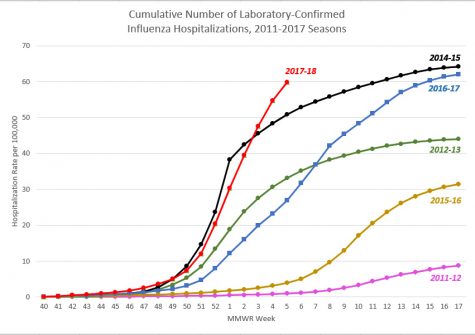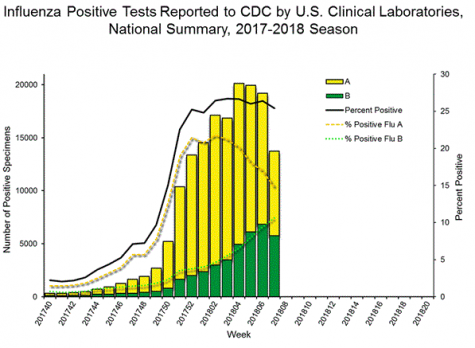The Breakdown of This Year’s Nasty Flu Season
Is it a common cold? No, it’s much worse.
The 2017-18 flu season has plowed it’s way across the country, triggering alarm and fear in our schools, workplaces, and homes. The levels of people reporting flu-like illness are now as high as the CDC observed at the peak of the 2009 flu pandemic, leading experts to call this flu season “the worst in nearly a decade.” So far, the influenza has been responsible for 97 child deaths, 21,279 hospitalizations, and up to 4,000 deaths each week, according to the latest data from the Centers for Disease Control and Prevention.
In Chicago and the Florida Panhandle, school districts have had to close because so many people were out sick. Alabama even declared a public health emergency over the flu.
The flu crisis in the state of Michigan has been especially severe. The two cities of Grand Rapids and Detroit have been ranked among most at-risk in the US for flu, according to the Doctors Report Illness Tracker app and website.
*drag the arrow bar to the left and right to compare the extent of the two flu seasons*
*as this graphic displays, Feb 2018 saw more widespread flu activity than Feb 2016*
“The flu season began around late-October and is expected to end as late as May,” said Dr. Anne Schuchat, acting director of the CDC. “So we are just a little over halfway through the season and could be looking at several more weeks of intense activity…the flu is far from over.”
To make matters worse, there’s also an ongoing shortage of saline IV bags to treat the masses of people going to the hospital. That’s because this year’s flu season followed Hurricane Maria in Puerto Rico, where almost half of the IV bags used in America’s hospitals are made. The hurricane’s hindrance of production coincided with an increased demand for saline because of flu, leaving hospitals and the Food and Drug Administration scrambling to fix the problem.
“Last month, we ran out of IV bags, and ended up having to use Gatorade to combat the [patients’] dehydration,” said Dr. Chi Zhang, a family medicine doctor at the Beaumont Hospital in Detroit, Michigan. “This is a nationwide problem that needs to be addressed.”
According to the Smithsonian Magazine, the 2017-18 flu season has exposed a critical flaw in our distribution of medical supplies. Read this article to learn more! https://t.co/YYoAgjUiCB
— Jenny She (@jennyshe30) March 1, 2018
Why This Year’s Flu Season is So Severe
So what exactly is the perfect storm behind this year’s nasty flu season?
According to the CDC, the H3N2 strain is the culprit of this year’s intense flu season. It is one of two Influenza A strains, the other being H1N1.
Dr. Zhang has noticed this difference in strains of the virus and is worried about the health issues that may arise from the change.
“It’s unusual that H3N2 is more dominant,” said Dr. Zhang. “We observed the H3N2 in Australia during their last winter [which takes place during our summer], and it is the strain that causes higher hospitalization and death rates.”
Compared with other strains, H3N2 can kick the body’s immune system into overdrive, which causes more inflammation, takes longer to fight, and makes people feel sicker. It could even be deadly if a patient doesn’t get medical aid quickly.
In addition, two strains of the flu virus are currently active at the same time.
“Typically, Influenza A tends to run its course in the fall,” continued Dr. Zhang. “Influenza B tends to be a bit milder and runs its course in the spring. But this year, both strains are circulating at the same time, creating a very dramatic [flu] season.”
What’s worse, the CDC reported that the flu vaccine is just 25% effective against the H3N2 strain.
“But that doesn’t mean you can skip the shot. Health professionals still agree that it can help make your flu symptoms less severe and help you avoid getting the flu…the flu shot is still a must and the number one way you can protect yourself,” said Dr. Zhang.
The Bloomfield Hills Perspective
The epidemic’s impact is evident just by looking at student absence data in high schools. Elizabeth Allen, attendance secretary at Bloomfield Hills High School, noticed the attendance plunge during the flu season.
“998 students were absent during the week of Feb 5-9, 2018 compared to 418 students from the week of September 25-29, 2017,” she said.
“We probably hit the peak of the flu season that week in February, because it was crazy…I’ve never seen so many students absent before,” she said. “The week during the flu season had more than twice the number of absences than the week not during flu season.”
BHHS English teacher and mother Krista Laliberte agrees, noting that she was shocked by the number of students who were unable to make it to school because of the flu.
“We went through a month where there was continuously a large number of kids gone on any given week or class…in all my years of teaching, this has been very rare,” she said. “In my daughter’s class, she was one of eight kids, in a class of twenty-two, that was out due to the flu. That’s a lot of kids that are out at once.”
Flu symptoms often include fever, chills, headache, malaise, muscle pain, cough, and sore throat. As stated by the CDC, these symptoms come on really fast — within 24 hours or so — and are usually extreme compared to those of the common cold.
Senior Ember Stuart contracted the flu back in January and was surprised by the severity of her symptoms.
“I woke up one morning with a migraine, a splitting headache, high fever, and horrible cold sweats. I was shaking, and every part of my body just hurt so bad,” she said. “At first, I blamed all of it on anxiety over the [upcoming] finals week, but eventually I couldn’t disregard the signs and ended up going to the doctor’s, where I was diagnosed with Influenza A.”
With the huge amount of schoolwork being given to students nowadays, it may be hard for them to catch up on all the assignments that were left undone during a sickness leave. Stuart explains that along with causing physical pain, the flu prompted stress and pressure to keep up with schoolwork during her absence.
“I had to miss all of finals week because of the flu, and it was really hard to get back on track and communicate to my teachers what my conditions were and what I could do about missing final exams,” she continued.
In the case of the flu, it is important for teachers to play the role of a guiding and understanding adult. Laliberte explains that not only should teachers be encouraging proper sanitation in classrooms, but they should also be more compassionate and have a flexible assignment schedule to fit the students’ circumstances.
“It’s essential that teachers be sympathetic towards the kids and set up the class curriculum in a way in which all students can still be successful even if they have to miss a few classes,” she said. “We all have to be to make sure that the kids fully recover and allow them time to do so.”
A Roundup of the 2017-18 Flu Season
*updated June 14, 2018*
This year’s deadly flu epidemic once again reminds individuals of their mortality. As for the next winter, all that can be said is: hope for the best, and prepare for the worst.
What did you think of this year's flu season?
- It was not bad at all (9%, 7 Votes)
- It was ok (18%, 15 Votes)
- It was VERY bad (73%, 60 Votes)
Total Voters: 82

Hi, my name is Jenny She and I am a Managing Editor on the Hawkeye newspaper. I am a senior this year and this is also my 4th year on staff. Outside...









David Margus • Jun 15, 2018 at 8:49 pm
Wow, this was such a great multimedia package! The different elements to the story were so helpful and creative. Great writing and visuals! Love the interactive aspect !